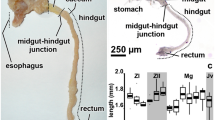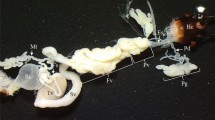Abstract
The ultrahistology of the ‘hindgut’ of the spider miteTetranychus urticae is described, a new terminology of the histological portions, based on the presence and absence of cuticle, is presented, and functional characteristics are discussed.
The alimentary canal of the spider mite consists of the cuticle-lined foregut (pharynx, esophagus, esophageal valve), a cuticle-free midgut, and a cuticle-lined hindgut with anal slit. The portions of the midgut are the ventriculus with three cranial and two caudal caeca, and the posterior midgut with two distinct cell types. Both portions are separated by a sphincter. The anterior lateral walls of the ∇-shaped posterior midgut which terminates in the dorsal region of the ventriculus show histological variability. Cells are either asymmetrical with long apical projections (=typical transporting epithelium) or show resorptive characteristics and storage products (=resorptive epithelium). The dorsal and posterior lateral epithelium consists of flat glandular cells containing large granular secretion grana. It is suggested that these cells synthesize mucoid substances for the facilitation of excretion transport.
The differentiation and function of the posterior midgut epithelium are discussed with respect to the formation of different elimination products.
Similar content being viewed by others
References
Akimov, V.A., 1973. On the morphological and physiological characteristics of the alimentary canal of the bulb miteRhizoglyphus echinopus (Fumouze and Robin). Proc. 3rd Int. Congr. Acarol., Prague, Academia, Prague, pp. 703–706.
Akimov, I.A. and Barabanova, V.V., 1978. Morphological and functional characteristics of the digestive system in tetranychid mites (Trombidiformes, Tetranychoidea). Entomol. Oboszr., 56: 912–922.
Alberti, G., 1973. Ernährungsbiologie und Spinnvermögen der Schnabelmilben (Bdellidae, Trombidiformes). Z. Morph. Tiere, 76: 285–338.
Anwarullah, M., 1963. Beiträge zur Morphologie und Anatomie einiger Tetranychiden (Acari, Tetranychidae). Angew. Zool., 50: 385–426.
Baker, R.A., 1975. The structure and function of the alimentary canal inHistiogaster carpio (Kramer, 1881) Acari: Sarcoptiformes. Acarologia, 17: 126–137.
Baker, E.W. and Wharton, G.W., 1952. An Introduction to Acarology. McMillan, New York, NY, 465 pp.
Blauvelt, W.E., 1945. The internal morphology of the common red spider mite (Tetranychus telarius Linn.). Mem. Cornell Exp. Stn., Ithaca, 270: 1–35.
Bradley, T.J., 1984. Mitochondrial placement and function in insect ion-transporting cells. Am. Zool., 24: 157–167.
Brody, A.R., McGrath, J.C. and Wharton, G.W., 1972.Dermatophagoides farinae: the digestive system. J.N.Y. Entomol. Soc., 53: 152–177.
Cioffi, M., 1984. Comparative ultrastructure of arthropod transporting epithelia. Am. Zool., 24: 139–156.
Czihak, G., Langer, H. and Ziegler, J. (Editors), 1976. Biologie. Springer, Berlin, Heidelberg, New York.
Ehara, S., 1960. Comparative studies on the internal anatomy of three Japanese trombidiform acarinids. J. Fac. Sci. Hokkaido Univ. Ser. VI, Zool., 14: 410–434.
Evans, G.O., Sheals, J.G., and McFarlane, D., 1961. The Terrestrial Acari of the British Isles. British Museum, London.
Hartenstein, R., 1970. Nitrogen metabolism in non-insect arthropods. In: J.E. Campbell (Editor), Comparative Biochemistry of Nitrogen Metabolism. Vol. 1. The Invertebrates. Academic Press, London, New York, pp. 299–385.
Hughes, T.E., 1950. The physiology of the alimentary canal ofTyroglyphus farinae. Q.J. Microsc. Sci., 91: 45–61.
Hughes, T.E., 1952. The morphology of the gut ofBdellonyssus bacoti (Hirst 1913). Ann. Trop. Med. Parasitol., 46: 362–374.
Hughes, T.E., 1959. Mites or the Acari. Athlone Press, University of London, London.
Hughes, T.E. and Huges, A.M., 1938. The internal anatomy and post-embryonic development ofGlycophagus domesticus De Geer. Proc. Zool. Soc. London, 108: 715–733.
Humiczewska, M. and Mielnicka, M.E., 1983. Histochemical observations on the alimentary tract and digestion process inTetranychus urticae Koch (Acari, Tetranychoides). Folia Biol., 31: 193–206.
Kaufman, W.R. and Sauer, J.R., 1982. Ion and water balance in feeding ticks: mechanisms tick excretion. In: D.F. Obenchain and R. Galun (Editors), Physiology of Ticks. Pergamon Press, Oxford, pp. 213–244.
Krantz, J.G., 1978. A Manual of Acarology. Oregon State Univ. Book Stores, Inc., Corvallis, OR.
Kuo, J.S. and Nesbitt, H.H.J., 1970. The internal morphology and histology of adultCaloglyphus mycophagus (Megnin) (Acarina: Acaridae). Can. J. Zool., 48: 505–518.
Marshall, A.T. and Wright, A., 1974. Ultrastructural changes associated with osmoregulation in the hindgut cells of a salt-water insect,Ephydrella sp. (Ephydridae, Diptera). Tissue Cell, 6: 301–318.
Martoja, R. and Ballan-Dufrancais, C., 1982. The ultrastructure of the digestive and excretory organs. In: R.C. King and H. Akai (Editors), Insect Ultrastructure. Plenum Press, New York, London, Vol. 2, pp. 199–268.
McEnroe, W.D., 1961. Guanine excretion by the two-spotted spider miteTetranychus telarius. Ann. Entomol. Soc. Am., 54: 925–926.
McEnroe, W.D., 1963. The role of the digestive system in the water balance of the twospotted spider mite. Adv. Acarol., 1: 225–231.
Mothes-Wagner, U., 1982. Feinstrukturelle Untersuchungen an der phytopathogenen SpinnmilbeTetranychus urticae (Acari, Tetranychidae) und zur Wirkungsweise der in der Erprobung befindlichen Nikkomycine als Bekämpfungsmittel. Diss. Univ. Marburg, p. 239.
Mothes-Wagner, U., 1985. Midgut cells as equivalents to the insect fat body in the twospotted spider miteTetranychus urticae. (in prep.).
Mothes, U. and Seitz, K.A., 1980. Licht-und elektronenmikroskopische Untersuchungen zur Funktionsmorphologie vonTetranychus urticae (Acari, Tetranychidae). I. Exkretionssysteme. Zool. Jb. Anat. 104, 500–529.
Mothes, U. and Seitz, K.A., 1981. Functional microscopic anatomy of the digestive system ofTetranychus urticae (Acari, Tetranychidae). Acarologia, 22: 257–270.
Mothes-Wagner, U., Wagner, G., Reitze, H.K. and Seitz, K.A., 1984. A standardized technique for the in toto epoxy resin embedding and precipitate-free staining of small specimens covered by strong protective outer surfaces. J. Miscrosc., 134: 307–313.
Paran, T.P., 1979. Evolution of the excretory duct inMyobia murismusculi (Schrank, 1781) Myobiidae (Trombidiformes-Acarina). Acarologia, 21: 55–60.
Prasse, J., 1967. Zur Anatomie und Histologie der Acaridae mit besonderer Berücksichtigung vonCaloglyphus berlesei (Michael, 1903) undC. michaeli (Oudemans, 1924). I. Das Darmsystem. Wiss. Z. Univ. Halle, 16: 789–812.
Rohde, C.J. and Oemick, D.A., 1967. Anatomy of the digestive and reproductive systems in an acarid mite (Sarcoptiformes). Acarologia, 9: 608–639.
Schlüter, U., 1980. Rectalpapillen und Funktion des Enddarms chilognather Diplopoden. Zool. Jb. Anat., 103: 607–639.
Seifert, G., 1970. Entomologisches Praktikum. Thieme Verlag, Stuttgart.
Vistorin, H.E., 1969. Ernährungsbiologie und Anatomie des Verdauungstraktes der Nicoletiellidae (Acari, Trombidiformes). Acarologia, 21: 205–215.
Wiesmann, R., 1968. Untersuchungen über die Verdauungsvorgänge bei der gemeinen SpinnmilbeTetranychus urticae Koch. Z. Angew. Entomol., 61: 457–465.
Author information
Authors and Affiliations
Rights and permissions
About this article
Cite this article
Mothes-Wagner, U. Fine structure of the ‘hindgut’ of the two-spotted spider mite,Tetranychus urticae, with special reference to origin and function. Exp Appl Acarol 1, 253–272 (1985). https://doi.org/10.1007/BF01198522
Accepted:
Issue Date:
DOI: https://doi.org/10.1007/BF01198522




